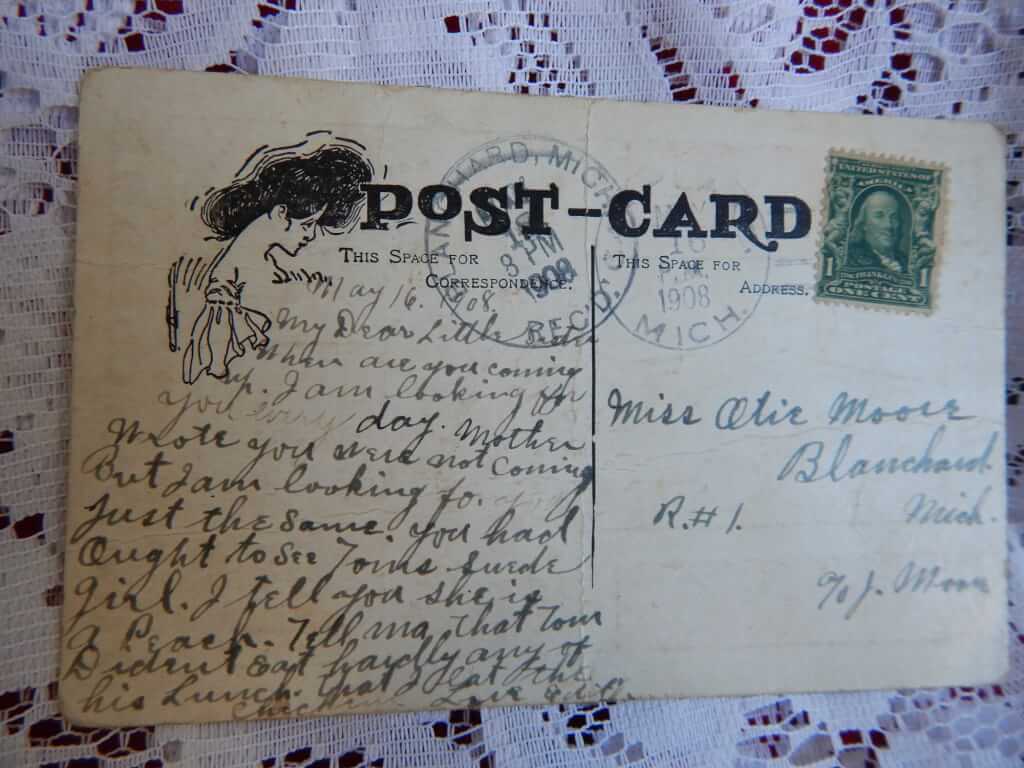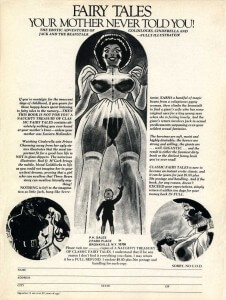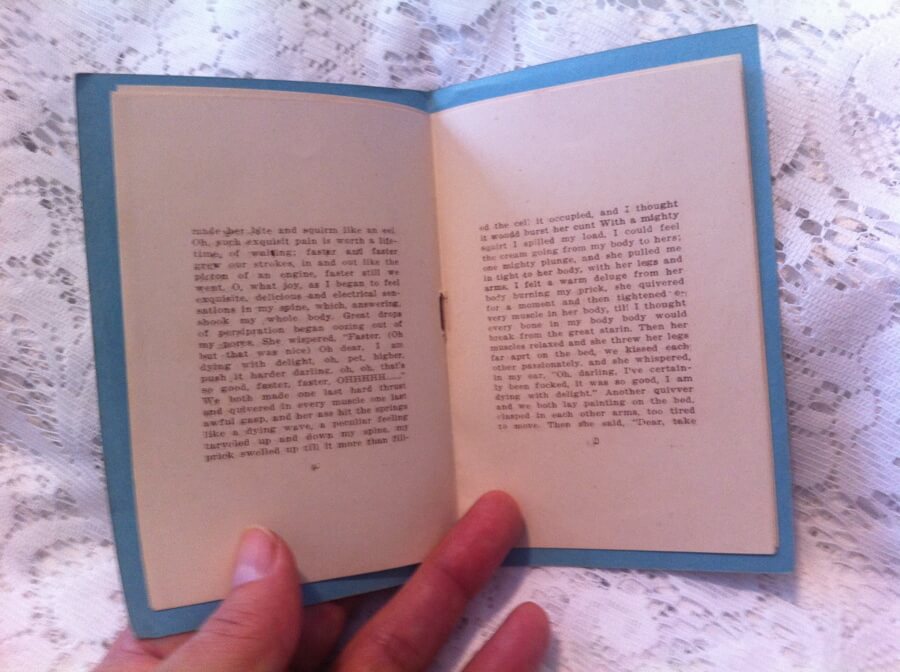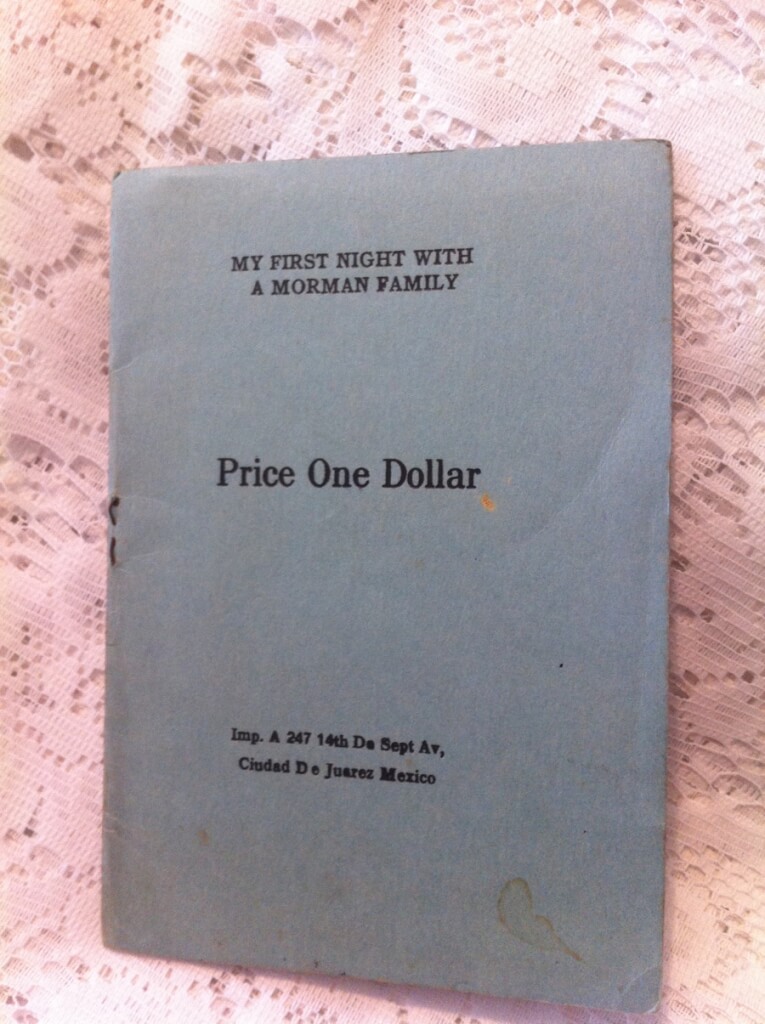-

 One Hundred Merrie and Delightsome Stories, ed. by Antoine de La Sale, trans. Robert B. Douglas (Charles Carrington, Paris, 1899 [first edition, first english translation]) 8" X 5.75", xxx 532pp, 3/4 tan morocco leather over marbled boards, gilt title on spine, 5 raised bands, marbled endpapers, excellent condition for age, ribbon intact, small tear at top of front cover. No illustrations One Hundred Merrie And Delightsome Stories (from the original French "Cent Nouvelles nouvelles" France, c. 1456-1461) is a collection of stories supposed to be narrated by various persons at the court of Philippe le Bon, and collected together by Antoine de la Sale in the mid 15th century. Charles Carrington was the first to have this translated into English. This edition does not contain the illustrations which were sold separately.
One Hundred Merrie and Delightsome Stories, ed. by Antoine de La Sale, trans. Robert B. Douglas (Charles Carrington, Paris, 1899 [first edition, first english translation]) 8" X 5.75", xxx 532pp, 3/4 tan morocco leather over marbled boards, gilt title on spine, 5 raised bands, marbled endpapers, excellent condition for age, ribbon intact, small tear at top of front cover. No illustrations One Hundred Merrie And Delightsome Stories (from the original French "Cent Nouvelles nouvelles" France, c. 1456-1461) is a collection of stories supposed to be narrated by various persons at the court of Philippe le Bon, and collected together by Antoine de la Sale in the mid 15th century. Charles Carrington was the first to have this translated into English. This edition does not contain the illustrations which were sold separately. -
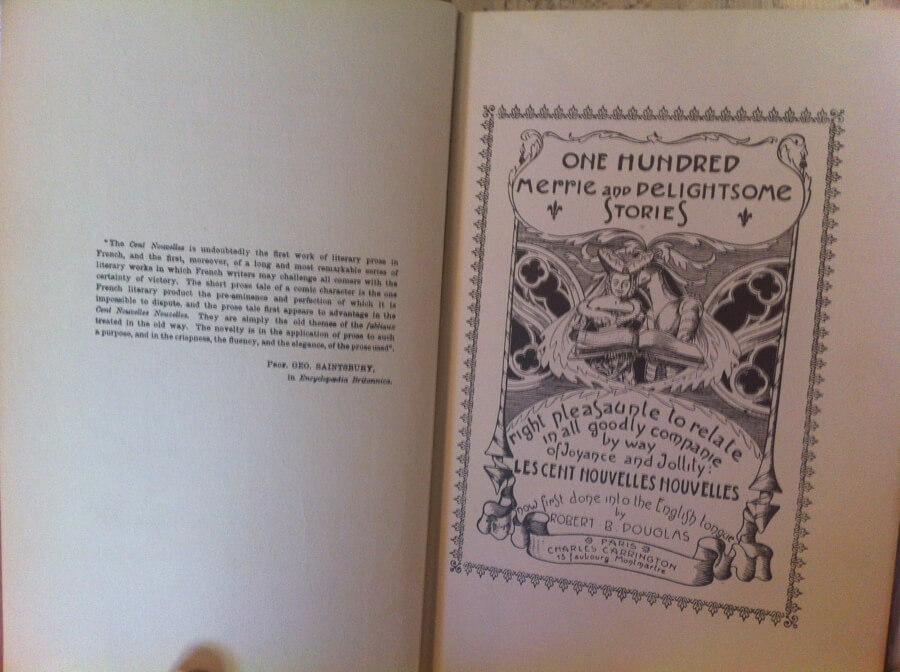
 One Hundred Merrie and Delightsome Stories, ed. by Antoine de La Sale, trans. Robert B. Douglas (Charles Carrington, Paris, 1899 [pirated facimile reprint, probably New York, c.1930 states "privately printed from the Charles Carrington Paris 1899 edition] #294/1250) 8" X 5.75", two volumes, xxx+532pp, pagination continuous. Fifty-two b&w plates by Léon Lebègue, marbled boards, gilt on spine, top edge gilt, other edges deckled, very good condition, minor bumping, some stains on front cover of vol. 2 Charles Carrington was the first to have this translated into English. This is a pirated copy, but still very nicely printed on good paper, the illustrations are in B&W. Purported a collection of short stories narrated by various persons at the court of Philippe le Bon, and collected together by Antoine de la Sale, the nouvelles are, according to the authority on French Literature—Professor George Saintsbury "undoubtedly the first work of literary prose in French ... The short prose tale of a comic character is the one French literary product the pre-eminence and perfection of which it is impossible to dispute, and the prose tale first appears to advantage in the Cent Nouvelles Nouvelles." The stories give a curious glimpses of life in the 15th century, providing a genuine view of the social condition of the nobility and the middle classes. M. Lenient, a French critic, says: "Generally the incidents and personages belong to the bourgeoisée; there is nothing chivalric, nothing wonderful; no dreamy lovers, romantic dames, fairies, or enchanters. Noble dames, bourgeois, nuns, knights, merchants, monks, and peasants mutually dupe each other. The lord deceives the miller's wife by imposing on her simplicity, and the miller retaliates in much the same manner. The shepherd marries the knight's sister, and the nobleman is not over scandalized. The vices of the monks are depicted in half a score tales, and the seducers are punished with a severity not always in proportion to the offence." For four centuries 10 of the stories were credited to Louis XI. Modern scholars have since ascribed them to either Philippe le Bel or Comte de Charolais. In all, some thirty-two noblemen or squires contributed the stories, with some 14 or 15 taken from Giovanni Boccaccio, and as many more from Gian Francesco Poggio Bracciolini or other Italian writers, or French fabliaux, but about 70 of them appear to be original.
One Hundred Merrie and Delightsome Stories, ed. by Antoine de La Sale, trans. Robert B. Douglas (Charles Carrington, Paris, 1899 [pirated facimile reprint, probably New York, c.1930 states "privately printed from the Charles Carrington Paris 1899 edition] #294/1250) 8" X 5.75", two volumes, xxx+532pp, pagination continuous. Fifty-two b&w plates by Léon Lebègue, marbled boards, gilt on spine, top edge gilt, other edges deckled, very good condition, minor bumping, some stains on front cover of vol. 2 Charles Carrington was the first to have this translated into English. This is a pirated copy, but still very nicely printed on good paper, the illustrations are in B&W. Purported a collection of short stories narrated by various persons at the court of Philippe le Bon, and collected together by Antoine de la Sale, the nouvelles are, according to the authority on French Literature—Professor George Saintsbury "undoubtedly the first work of literary prose in French ... The short prose tale of a comic character is the one French literary product the pre-eminence and perfection of which it is impossible to dispute, and the prose tale first appears to advantage in the Cent Nouvelles Nouvelles." The stories give a curious glimpses of life in the 15th century, providing a genuine view of the social condition of the nobility and the middle classes. M. Lenient, a French critic, says: "Generally the incidents and personages belong to the bourgeoisée; there is nothing chivalric, nothing wonderful; no dreamy lovers, romantic dames, fairies, or enchanters. Noble dames, bourgeois, nuns, knights, merchants, monks, and peasants mutually dupe each other. The lord deceives the miller's wife by imposing on her simplicity, and the miller retaliates in much the same manner. The shepherd marries the knight's sister, and the nobleman is not over scandalized. The vices of the monks are depicted in half a score tales, and the seducers are punished with a severity not always in proportion to the offence." For four centuries 10 of the stories were credited to Louis XI. Modern scholars have since ascribed them to either Philippe le Bel or Comte de Charolais. In all, some thirty-two noblemen or squires contributed the stories, with some 14 or 15 taken from Giovanni Boccaccio, and as many more from Gian Francesco Poggio Bracciolini or other Italian writers, or French fabliaux, but about 70 of them appear to be original. -
Out of stock

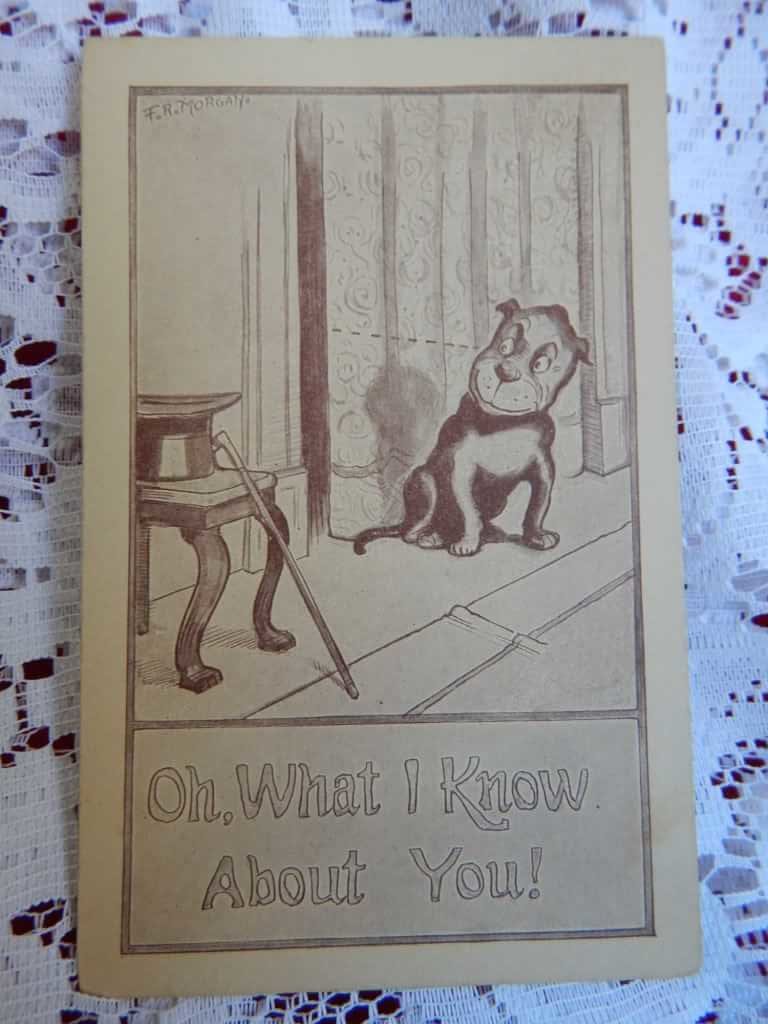 Oh What I Know About You! postcard
Oh What I Know About You! postcard -

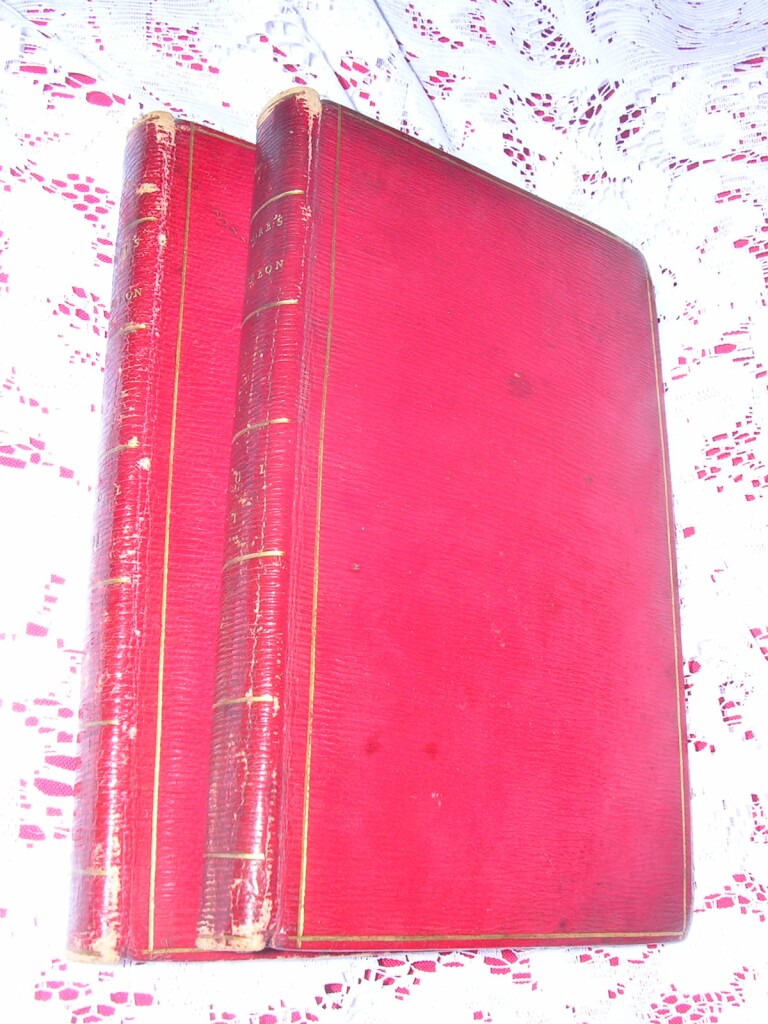 Odes of Anacreon, Anacreon, trans. Thomas Moore (J. and T. Carpenter, London, 1802) 6 1/2" X 4 1/4", 2 vol. 163pp 148pp, hardbound in red morocco with gilt lettering and decorations, gilted edges, marbled boards, worn edges and corners befitting it's age, binding tight, ribbon markers intact. Armorial bookplate of british judge, Geoffrey Lord Cross of Chelsea on front pastedowns Anacreon (582 BC _ 485 BC) was a Greek lyric poet, notable for his drinking songs and hymns. Later Greeks included him in the canonical list of nine lyric poets. Thomas Moore (1779 _ 1852) is considered Ireland's "National Bard". He was a poet, singer, songwriter, and entertainer. He was responsible, with John Murray, for burning Lord Byron's memoirs after his death. These books are the second edition (original edition published in 1800) of his first work, a translation that he did at Middle Temple where he studied law. In his lifetime he was often referred to as Anacreon Moore.
Odes of Anacreon, Anacreon, trans. Thomas Moore (J. and T. Carpenter, London, 1802) 6 1/2" X 4 1/4", 2 vol. 163pp 148pp, hardbound in red morocco with gilt lettering and decorations, gilted edges, marbled boards, worn edges and corners befitting it's age, binding tight, ribbon markers intact. Armorial bookplate of british judge, Geoffrey Lord Cross of Chelsea on front pastedowns Anacreon (582 BC _ 485 BC) was a Greek lyric poet, notable for his drinking songs and hymns. Later Greeks included him in the canonical list of nine lyric poets. Thomas Moore (1779 _ 1852) is considered Ireland's "National Bard". He was a poet, singer, songwriter, and entertainer. He was responsible, with John Murray, for burning Lord Byron's memoirs after his death. These books are the second edition (original edition published in 1800) of his first work, a translation that he did at Middle Temple where he studied law. In his lifetime he was often referred to as Anacreon Moore. -
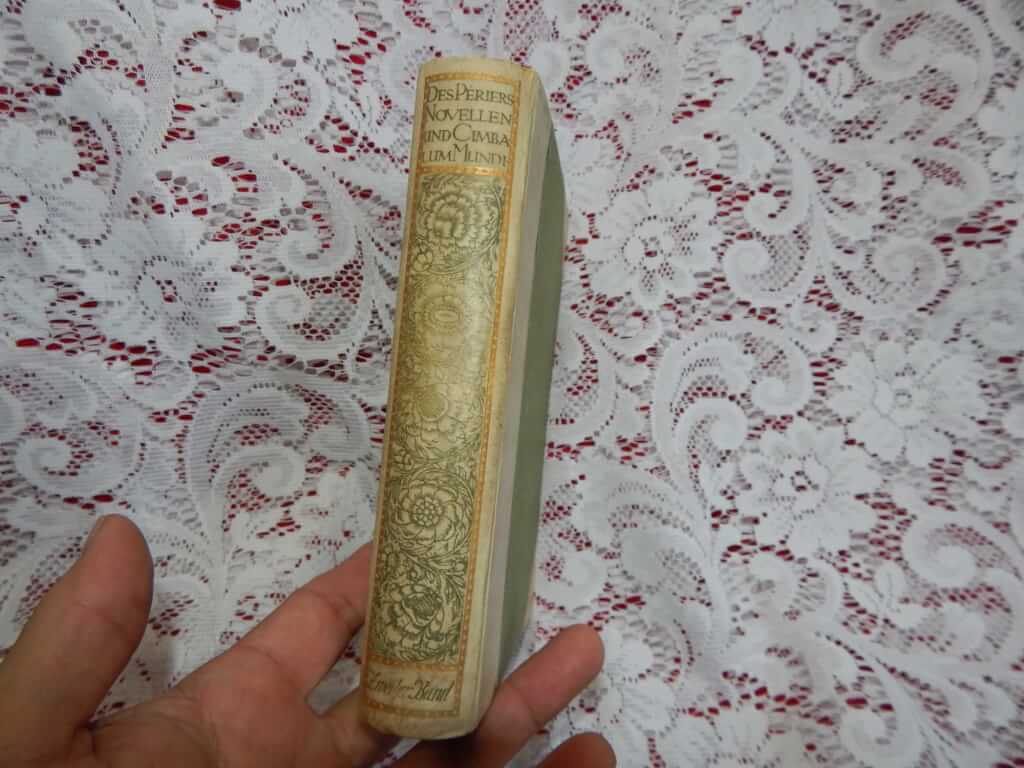
 Novellen und Cymbalum Mundi: Die neuen Schwänke und lustigen Unterhaltungen gefolgt von der Weltbimmel (VOL 2 only), by Bonaventure Des Periers. "For the first time translated from French and introduced by Hanns Floerke with 10 illustrations by Franz von Bayros" (Georg Müller, München und Leipzig 1910) 5.25"x7", 404pp, vol 2 of 2, top edge gilt, other edges deckled, 3/4 vellum on green boards, 5 illustrations by Bayros tipped in, ribbon present but detached, good+ condition. German translation of Des Periers short stories and Cymbalum Mundi, Four Very Ancient Joyous and Facetious Dialogues. Bonaventure des Périers (c. 1500 – 1544) was a French storyteller and humanist who attained notoriety as a freethinker. Margaret of Angoulême, queen of Navarre, made him her valet de chambre in 1536. He acted as her secretary and transcribed her Heptaméron; some maintain that he in fact wrote the work. The free discussions permitted at Margaret’s court encouraged a license of thought as displeasing to the Calvinists as to the Roman Catholics; it became skepticism in Des Périers’s Cymbalum Mundi, a brilliant and violent attack upon Christianity. The allegorical form of its four dialogues in imitation of the Greek rhetorician Lucian did not conceal its real meaning. It was suppressed (c. 1538), but it was reprinted in Paris in the same year. His book made many bitter enemies for Des Périers, who prudently left Paris and settled at Lyon. Tradition has it that he killed himself in 1544, but this is questionable. Franz von Bayros (1866–1924) was an Austrian commercial artist, illustrator, and painter, best known for his controversial Tales at the Dressing Table portfolio, a book considered so dangerous to the morality of the time that Von Bayros was arrested and forced into exile. He was obliged to move from one European capital to another as each outrageous new work was banned by the authorities.
Novellen und Cymbalum Mundi: Die neuen Schwänke und lustigen Unterhaltungen gefolgt von der Weltbimmel (VOL 2 only), by Bonaventure Des Periers. "For the first time translated from French and introduced by Hanns Floerke with 10 illustrations by Franz von Bayros" (Georg Müller, München und Leipzig 1910) 5.25"x7", 404pp, vol 2 of 2, top edge gilt, other edges deckled, 3/4 vellum on green boards, 5 illustrations by Bayros tipped in, ribbon present but detached, good+ condition. German translation of Des Periers short stories and Cymbalum Mundi, Four Very Ancient Joyous and Facetious Dialogues. Bonaventure des Périers (c. 1500 – 1544) was a French storyteller and humanist who attained notoriety as a freethinker. Margaret of Angoulême, queen of Navarre, made him her valet de chambre in 1536. He acted as her secretary and transcribed her Heptaméron; some maintain that he in fact wrote the work. The free discussions permitted at Margaret’s court encouraged a license of thought as displeasing to the Calvinists as to the Roman Catholics; it became skepticism in Des Périers’s Cymbalum Mundi, a brilliant and violent attack upon Christianity. The allegorical form of its four dialogues in imitation of the Greek rhetorician Lucian did not conceal its real meaning. It was suppressed (c. 1538), but it was reprinted in Paris in the same year. His book made many bitter enemies for Des Périers, who prudently left Paris and settled at Lyon. Tradition has it that he killed himself in 1544, but this is questionable. Franz von Bayros (1866–1924) was an Austrian commercial artist, illustrator, and painter, best known for his controversial Tales at the Dressing Table portfolio, a book considered so dangerous to the morality of the time that Von Bayros was arrested and forced into exile. He was obliged to move from one European capital to another as each outrageous new work was banned by the authorities. -
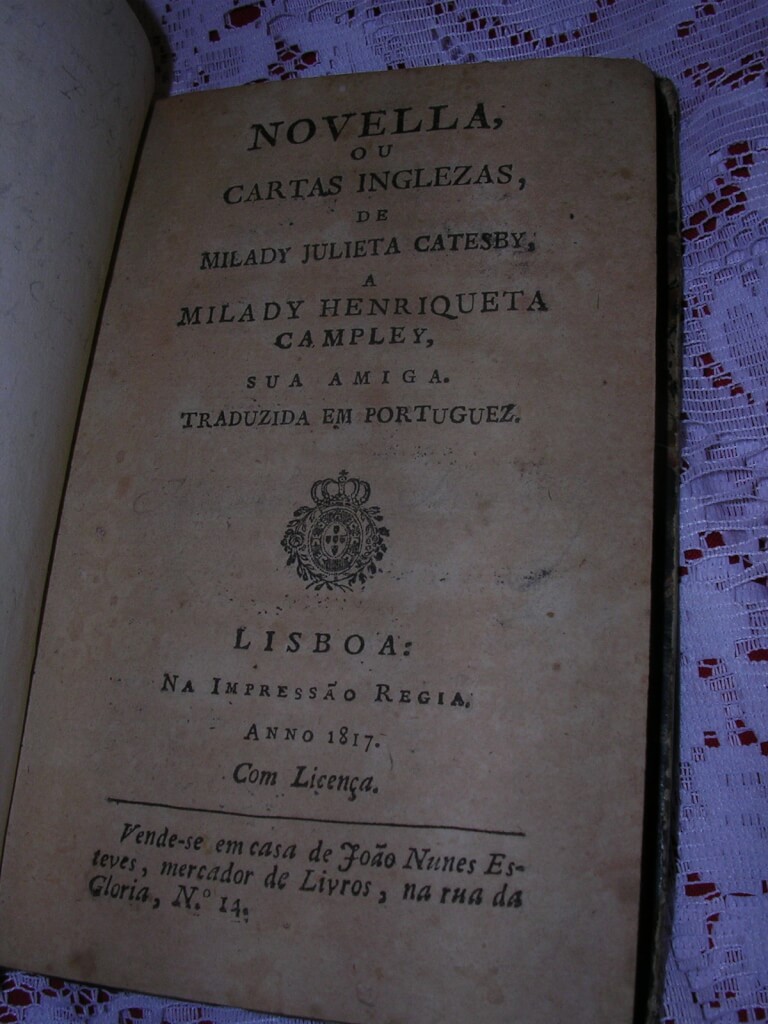
 none stated [Marie-Jeanne Riccoboni] (Na Impressão regia, vende se em casa de [sold in the house of] João Nunes Esteves, Lisboa, 1817) 6" x 3.75", 236pp, hardbound, quarter-leather with marbled paper boards. Gilt decorations and title on spine. Good condition for it's age, front boards cracked from spine but holding, edges worn, corners bumped, binding very good.
none stated [Marie-Jeanne Riccoboni] (Na Impressão regia, vende se em casa de [sold in the house of] João Nunes Esteves, Lisboa, 1817) 6" x 3.75", 236pp, hardbound, quarter-leather with marbled paper boards. Gilt decorations and title on spine. Good condition for it's age, front boards cracked from spine but holding, edges worn, corners bumped, binding very good. -

 Nouvelles de Jean Boccace, Giovanni Boccaccio, trans. Mirabeau, illus. Marillier, engraved by Ponce [according to the Museum of Fine Arts - Boston, "Illustrated by Clément Pierre Marillier, Engraved by Wilbrode-Magloire-Nicolas Courbe, Engraved by Remi Henri Joseph Delvaux, Engraved by Nicholas Ponce, Etched by Devilliers, Author Giovanni Boccaccio, Publisher L. Duprat, Letellier et Cie, Printer A. Egron"] (Chez L. Duprat, Paris, 1802) 8" X 5.25", 4 vol. xx 304pp, 273pp, 243pp, 293pp, leather bound with gilt decorations on spine and around edges of boards, marbled end papers, armorial bookplate of the Earl of Normanton on all vols. gilt edges (mostly soiled). Owner's signature on front pages "A. Baillu 1819" Ribbons intact. Numerous beautifuly and detailed plates throughout. Good condition for age. Honoré Gabriel Riqueti, Comte de Mirabeau (1749-1791) was a French writer, popular orator and statesman (who communicated with Thomas Jefferson and Benjamin Franklin). He is remembered for his books Erotica biblion, Ma conversion, and his love letters to Sophie which written during his imprisonment at the donjon de Vincennes between 1777-1780 (while another prisoner, the Marquis de Sade was also incarcerated there. Yes, they met... No, they didn't like each other.) This book was also written in the Vincennes prison. According to Mirabeau's biography this was a "collection presented as a translation of Boccaccio, but which, as the author himself confesses in his introduction, is nothing more than simple sketches of some of the tales in the Decameron.... Mirabeau imitated some of the licentious tales which alone are known to the general reader, but took no notice of the other articles which abound in the Decameron, because they neither suited his views nor the public taste." A beautiful and rare book with exquisite engravings. This book is in the collection at the MFA-Boston and other museums.
Nouvelles de Jean Boccace, Giovanni Boccaccio, trans. Mirabeau, illus. Marillier, engraved by Ponce [according to the Museum of Fine Arts - Boston, "Illustrated by Clément Pierre Marillier, Engraved by Wilbrode-Magloire-Nicolas Courbe, Engraved by Remi Henri Joseph Delvaux, Engraved by Nicholas Ponce, Etched by Devilliers, Author Giovanni Boccaccio, Publisher L. Duprat, Letellier et Cie, Printer A. Egron"] (Chez L. Duprat, Paris, 1802) 8" X 5.25", 4 vol. xx 304pp, 273pp, 243pp, 293pp, leather bound with gilt decorations on spine and around edges of boards, marbled end papers, armorial bookplate of the Earl of Normanton on all vols. gilt edges (mostly soiled). Owner's signature on front pages "A. Baillu 1819" Ribbons intact. Numerous beautifuly and detailed plates throughout. Good condition for age. Honoré Gabriel Riqueti, Comte de Mirabeau (1749-1791) was a French writer, popular orator and statesman (who communicated with Thomas Jefferson and Benjamin Franklin). He is remembered for his books Erotica biblion, Ma conversion, and his love letters to Sophie which written during his imprisonment at the donjon de Vincennes between 1777-1780 (while another prisoner, the Marquis de Sade was also incarcerated there. Yes, they met... No, they didn't like each other.) This book was also written in the Vincennes prison. According to Mirabeau's biography this was a "collection presented as a translation of Boccaccio, but which, as the author himself confesses in his introduction, is nothing more than simple sketches of some of the tales in the Decameron.... Mirabeau imitated some of the licentious tales which alone are known to the general reader, but took no notice of the other articles which abound in the Decameron, because they neither suited his views nor the public taste." A beautiful and rare book with exquisite engravings. This book is in the collection at the MFA-Boston and other museums. -
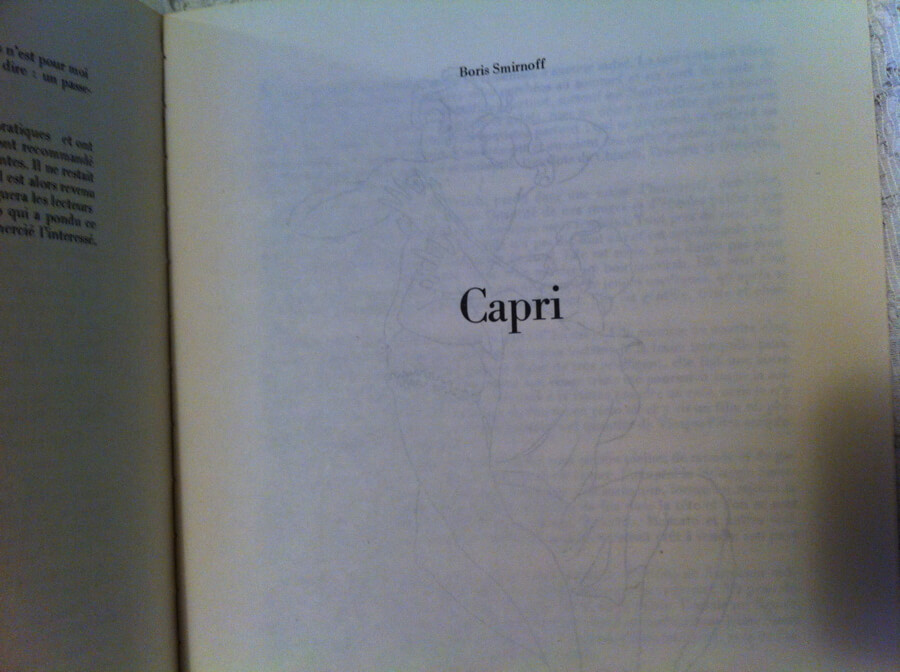
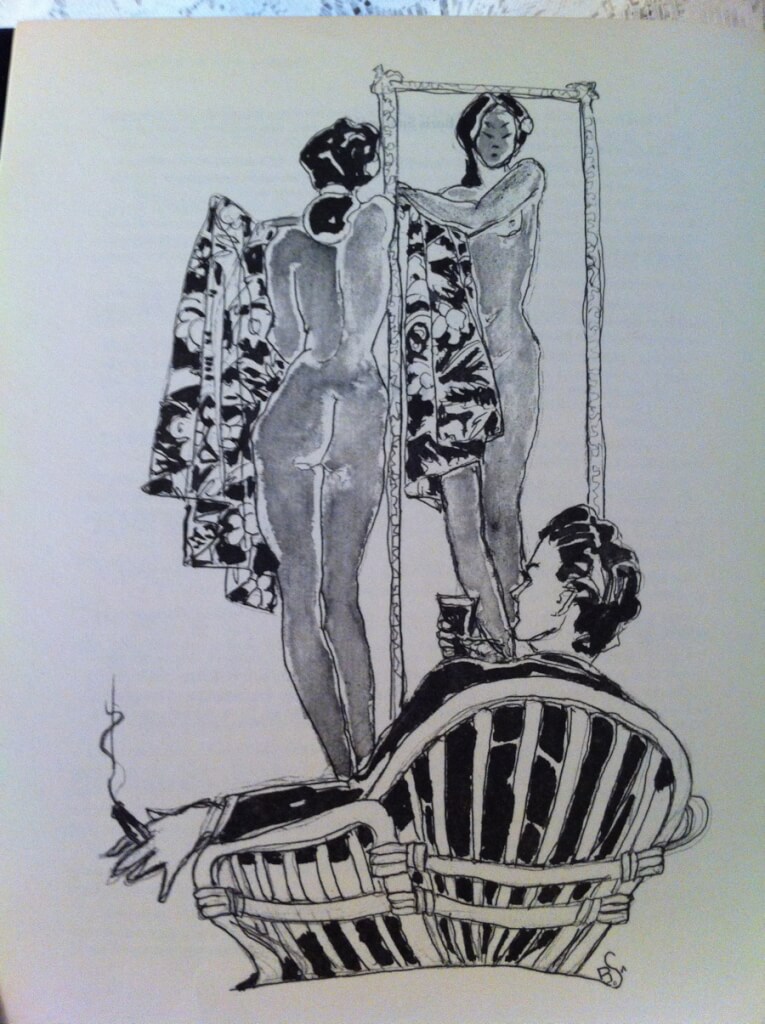 Nouvelles, Boris Smirnoff (Imprimerie Zimmermann, 1971) 9.75" x 7.75, soft cover, cover is black velvet, cover is loose, title page is unattached but the rest of the binding is holding. I do not find much mention of this book elsewhere. Very little is known to me about this book. I was able to find that Boris Smirnoff (1894 _ 1976), was born in Russia and settle in France following the "pogroms" of 1917. He was trained in the studio of Lucien Simon and attended the l'Ecole de Beaux-arts in Paris. He exhibited in Paris, London, Lisbon, New York, Stockholm, Bern, Geneva, Cairo, Palermo, Rome, Nice and Cannes and lived for most of his life in Cagnes-sur-Mer in the Alpes Maritimes. His works are held in museums throughout the world. These are erotic stories with illustrations by the author published in 1971.
Nouvelles, Boris Smirnoff (Imprimerie Zimmermann, 1971) 9.75" x 7.75, soft cover, cover is black velvet, cover is loose, title page is unattached but the rest of the binding is holding. I do not find much mention of this book elsewhere. Very little is known to me about this book. I was able to find that Boris Smirnoff (1894 _ 1976), was born in Russia and settle in France following the "pogroms" of 1917. He was trained in the studio of Lucien Simon and attended the l'Ecole de Beaux-arts in Paris. He exhibited in Paris, London, Lisbon, New York, Stockholm, Bern, Geneva, Cairo, Palermo, Rome, Nice and Cannes and lived for most of his life in Cagnes-sur-Mer in the Alpes Maritimes. His works are held in museums throughout the world. These are erotic stories with illustrations by the author published in 1971. -
 Ninety-Five Limericks | A Contribution to the Folk Lore of our Time | Collected and Edited by John Falmouth (The Limerick Press, Suffern, NY, 1932) 5"x7.25", unpaginated, protected DJ over tan cloth boards with red lettering and decorations, tears and soiling to DJ, some soiling on boards, interior good, previous owner added a limerick about a young man from Calcutta in the end pages. Mr. Falmouth has a 6 page forward where he discusses the phallic nature of the limerick (with diagrams). A fun little book even though the profanity is exed out.
Ninety-Five Limericks | A Contribution to the Folk Lore of our Time | Collected and Edited by John Falmouth (The Limerick Press, Suffern, NY, 1932) 5"x7.25", unpaginated, protected DJ over tan cloth boards with red lettering and decorations, tears and soiling to DJ, some soiling on boards, interior good, previous owner added a limerick about a young man from Calcutta in the end pages. Mr. Falmouth has a 6 page forward where he discusses the phallic nature of the limerick (with diagrams). A fun little book even though the profanity is exed out. -

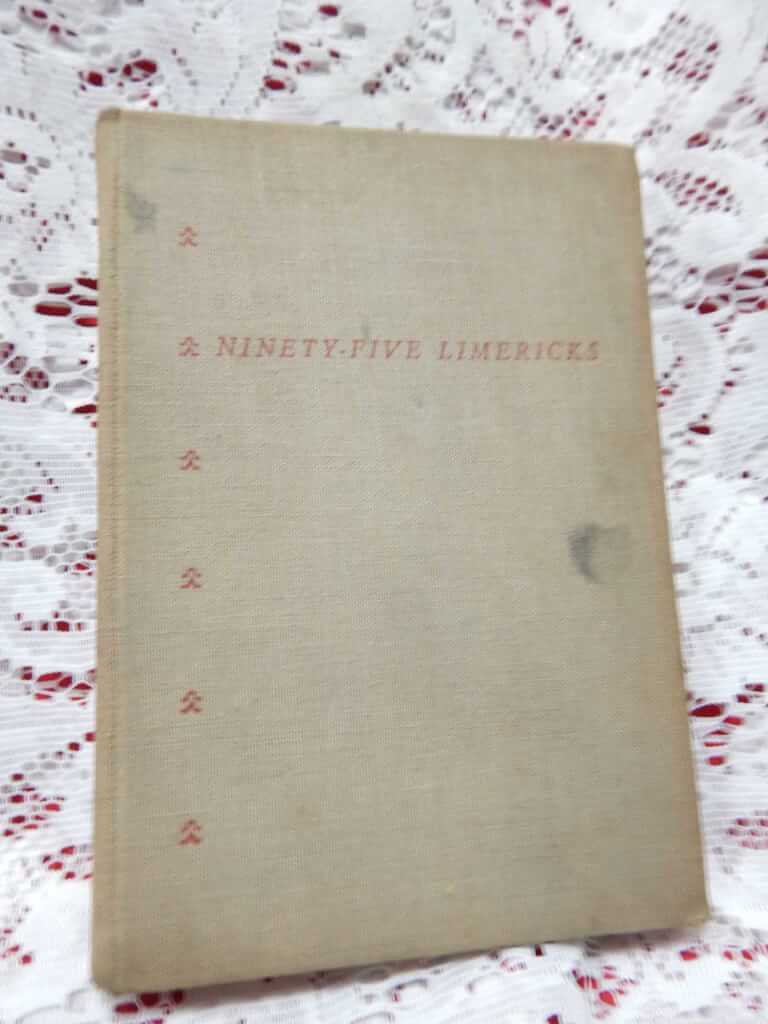 Ninety-Five Limericks | A Contribution to the Folk Lore of our Time | Collected and Edited by John Falmouth (The Limerick Press, Suffern, NY, 1932) 5"x7.25", unpaginated, tan cloth boards with red lettering and decorations, some soiling on boards, interior good, previous owner added a limerick about a young man from Calcutta in the end pages. Mr. Falmouth has a 6 page forward where he discusses the phallic nature of the limerick (with diagrams). A fun little book even though the profanity is exed out.
Ninety-Five Limericks | A Contribution to the Folk Lore of our Time | Collected and Edited by John Falmouth (The Limerick Press, Suffern, NY, 1932) 5"x7.25", unpaginated, tan cloth boards with red lettering and decorations, some soiling on boards, interior good, previous owner added a limerick about a young man from Calcutta in the end pages. Mr. Falmouth has a 6 page forward where he discusses the phallic nature of the limerick (with diagrams). A fun little book even though the profanity is exed out. -
Out of stock
 Nell in Bridewell (Lenchen im Zuchthause): Description of the System of Corporal Punishment (Flagellation) in the Female Prisons of South Germany up to the year 1848; a contribution to the history of manners., W. Reinhard, trans. W.C. Costello Ph. D. and A. R. Allinson M. A. (Psych Press [New York], 1932) 9 5/8" X 6 1/2", 326pp, hardbound, black cloth spine over orange cloth boards, gilt lettering and bands on spine, fore and bottom edge deckle, just good condition, soiling and rubbing on front cover, interior clean, some pages unopened, ex libris Joe H. and Bertha M. Shryock Although the title suggests that this is a "study", it goes beyond the facts and delves into the minds of those who are doing the punishing and those who are being humiliated and punished. Publishers of these "flagellation novels" would often lesson their liability by representing their books as academic studies. Often they would go unnoticed by the larger community unaware of the erotic nature of such a book to a certain segment of the public. In this book, Nell describes in graphic terms the merciless floggings she witnessed of girls and young women, as well as of boys and men and confesses to disturbingly confusing emotions that such sights occasioned in her. She recalls the lustful expressions on the faces of the onlookers, records the fervent words of gratitude to the skillful flogger from the lips of grand ladies who "were only too delighted to see such girls whipped", and tells of the evidently sensual appetites such cruelties incited in the torturers. This edition is a facsimile reprint of Carrington's 1900 translation. Added to it are very nice illustrations [woodcuts?] by an unknown artist.
Nell in Bridewell (Lenchen im Zuchthause): Description of the System of Corporal Punishment (Flagellation) in the Female Prisons of South Germany up to the year 1848; a contribution to the history of manners., W. Reinhard, trans. W.C. Costello Ph. D. and A. R. Allinson M. A. (Psych Press [New York], 1932) 9 5/8" X 6 1/2", 326pp, hardbound, black cloth spine over orange cloth boards, gilt lettering and bands on spine, fore and bottom edge deckle, just good condition, soiling and rubbing on front cover, interior clean, some pages unopened, ex libris Joe H. and Bertha M. Shryock Although the title suggests that this is a "study", it goes beyond the facts and delves into the minds of those who are doing the punishing and those who are being humiliated and punished. Publishers of these "flagellation novels" would often lesson their liability by representing their books as academic studies. Often they would go unnoticed by the larger community unaware of the erotic nature of such a book to a certain segment of the public. In this book, Nell describes in graphic terms the merciless floggings she witnessed of girls and young women, as well as of boys and men and confesses to disturbingly confusing emotions that such sights occasioned in her. She recalls the lustful expressions on the faces of the onlookers, records the fervent words of gratitude to the skillful flogger from the lips of grand ladies who "were only too delighted to see such girls whipped", and tells of the evidently sensual appetites such cruelties incited in the torturers. This edition is a facsimile reprint of Carrington's 1900 translation. Added to it are very nice illustrations [woodcuts?] by an unknown artist. -
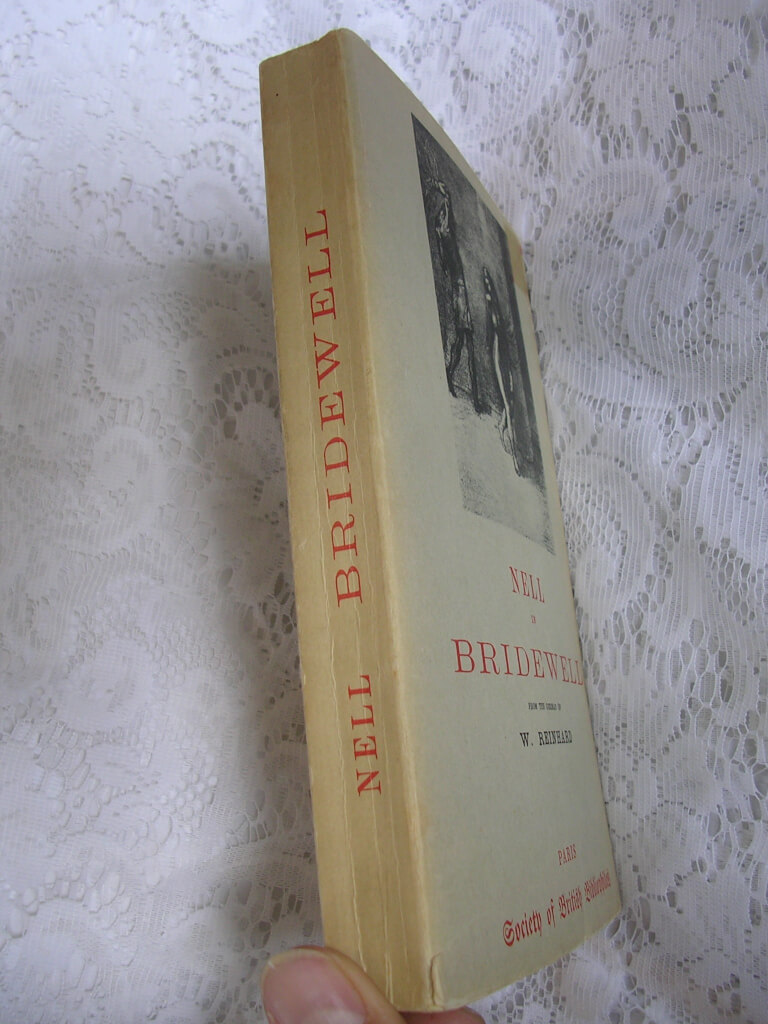
 Nell in Bridewell (Lenchen im Zuchthause), W. Reinhard, trans. W.C. Costello Ph. D. and A. R. Allinson M. A. (Society of British Bibliophiles, Paris, 1900) 8" X 5", 326pp, paperback, good condition, price tag mark on front cover, a tear and some bumping, spine is creased, binding is still good Subtitle: "Description of the System of Corporal Punishment (Flagellation) in the Female Prisons of South Germany up to the year 1848; a contribution to the history of manners." Although the title suggests that this is a "study", it goes beyond the facts and delves into the minds of those who are doing the punishing and those who are being humiliated and punished. Publishers of these "flagellation novels" would often lesson their liability by representing their books as academic studies. Often they would go unnoticed by the larger community unaware of the erotic nature of such a book to a certain segment of the public. In this book, Nell describes in graphic terms the merciless floggings she witnessed of girls and young women, as well as of boys and men and confesses to disturbingly confusing emotions that such sights occasioned in her. She recalls the lustful expressions on the faces of the onlookers, records the fervent words of gratitude to the skillful flogger from the lips of grand ladies who "were only too delighted to see such girls whipped", and tells of the evidently sensual appetites such cruelties incited in the torturers.
Nell in Bridewell (Lenchen im Zuchthause), W. Reinhard, trans. W.C. Costello Ph. D. and A. R. Allinson M. A. (Society of British Bibliophiles, Paris, 1900) 8" X 5", 326pp, paperback, good condition, price tag mark on front cover, a tear and some bumping, spine is creased, binding is still good Subtitle: "Description of the System of Corporal Punishment (Flagellation) in the Female Prisons of South Germany up to the year 1848; a contribution to the history of manners." Although the title suggests that this is a "study", it goes beyond the facts and delves into the minds of those who are doing the punishing and those who are being humiliated and punished. Publishers of these "flagellation novels" would often lesson their liability by representing their books as academic studies. Often they would go unnoticed by the larger community unaware of the erotic nature of such a book to a certain segment of the public. In this book, Nell describes in graphic terms the merciless floggings she witnessed of girls and young women, as well as of boys and men and confesses to disturbingly confusing emotions that such sights occasioned in her. She recalls the lustful expressions on the faces of the onlookers, records the fervent words of gratitude to the skillful flogger from the lips of grand ladies who "were only too delighted to see such girls whipped", and tells of the evidently sensual appetites such cruelties incited in the torturers. -
Out of stock

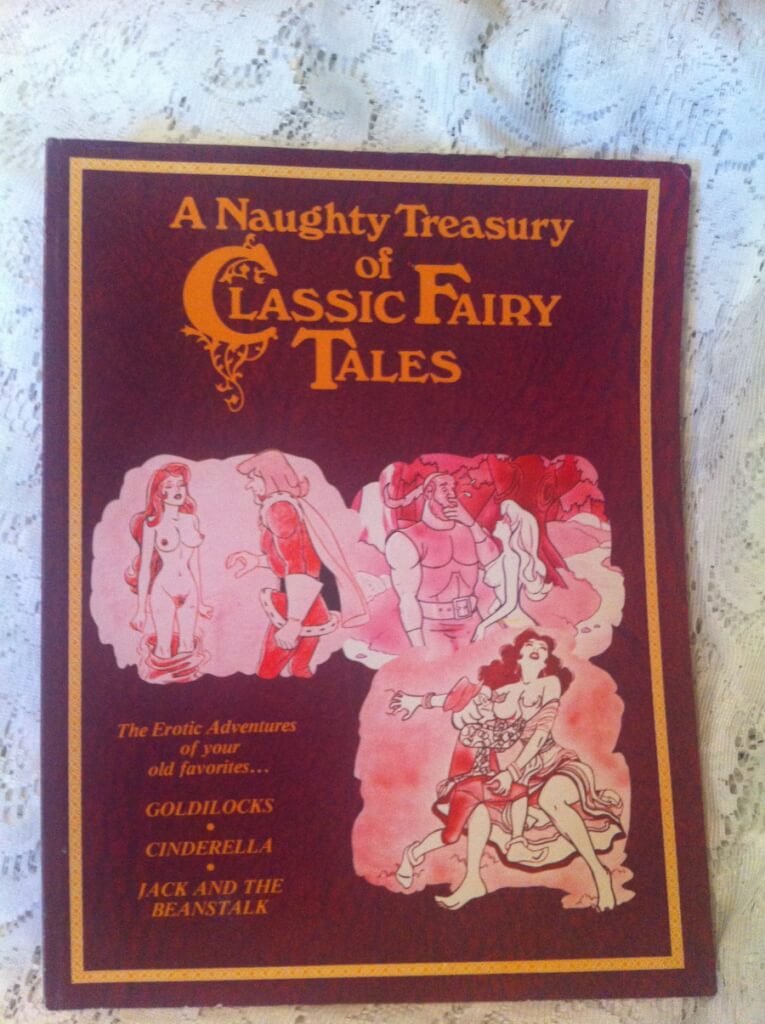 Naughty Treasury of Classic Fairy Tales, "Translated from the Old Saxon and Illustrated by Sir Rod Q. M'Gurk, Knight of the Brush (np, nd c. 1975) 8.5"x11", 96pp (unpaginated), soft covers, good condition, some minor bumping to corners, near fine internal pages I've been able to find a few references to this book and very little about "Sir Rod Q. M'Gurk". He apparently also had his cartoons published in Swank magazine c. 1976-7. Eventually it came to the attention of some illustrators and (with help of former Disney animators) was made into a movie by Don Jurwich (not sure the connection between him and Sir Rod Q. M'Gurk, but I'd love to know if it was him).
Naughty Treasury of Classic Fairy Tales, "Translated from the Old Saxon and Illustrated by Sir Rod Q. M'Gurk, Knight of the Brush (np, nd c. 1975) 8.5"x11", 96pp (unpaginated), soft covers, good condition, some minor bumping to corners, near fine internal pages I've been able to find a few references to this book and very little about "Sir Rod Q. M'Gurk". He apparently also had his cartoons published in Swank magazine c. 1976-7. Eventually it came to the attention of some illustrators and (with help of former Disney animators) was made into a movie by Don Jurwich (not sure the connection between him and Sir Rod Q. M'Gurk, but I'd love to know if it was him). -
 Napoleon et les Femmes | L 'amour, Frederick Masson, illus. A. Calbet (Librairie Borel, Paris, 1899 "Collection Nymphée") 7.5" X 3.75", 391pp.+, 3/4 blue leather over marbled blue silk-covered boards, 5 raised bands, top edge gilt, marbled end-papers, illustrations throughout This book focuses on the life of women under the Consulate and the Empire. It considers Napoleon’s conception of women, examining his contribution to the drafting of the Civil Code on the question of the place of women in society or the education of young girls. The memoirs and correspondence give an idea of how the women who lived through the Empire perceived this period of reforms, deprivation of freedoms, and also wars.
Napoleon et les Femmes | L 'amour, Frederick Masson, illus. A. Calbet (Librairie Borel, Paris, 1899 "Collection Nymphée") 7.5" X 3.75", 391pp.+, 3/4 blue leather over marbled blue silk-covered boards, 5 raised bands, top edge gilt, marbled end-papers, illustrations throughout This book focuses on the life of women under the Consulate and the Empire. It considers Napoleon’s conception of women, examining his contribution to the drafting of the Civil Code on the question of the place of women in society or the education of young girls. The memoirs and correspondence give an idea of how the women who lived through the Empire perceived this period of reforms, deprivation of freedoms, and also wars. -
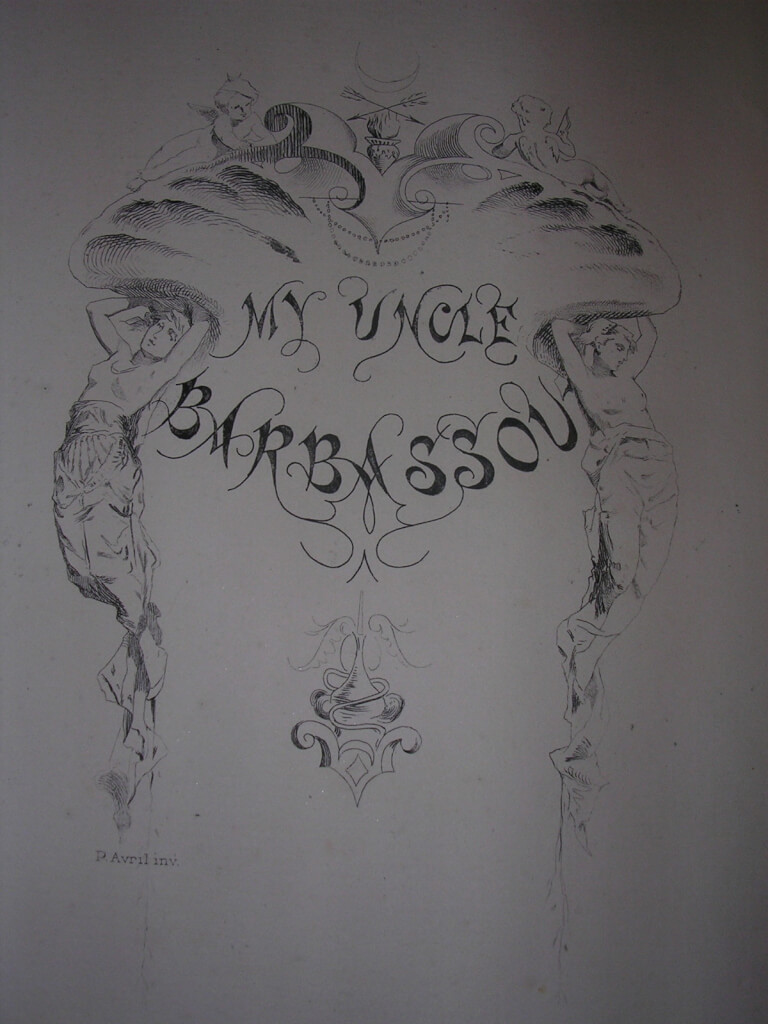
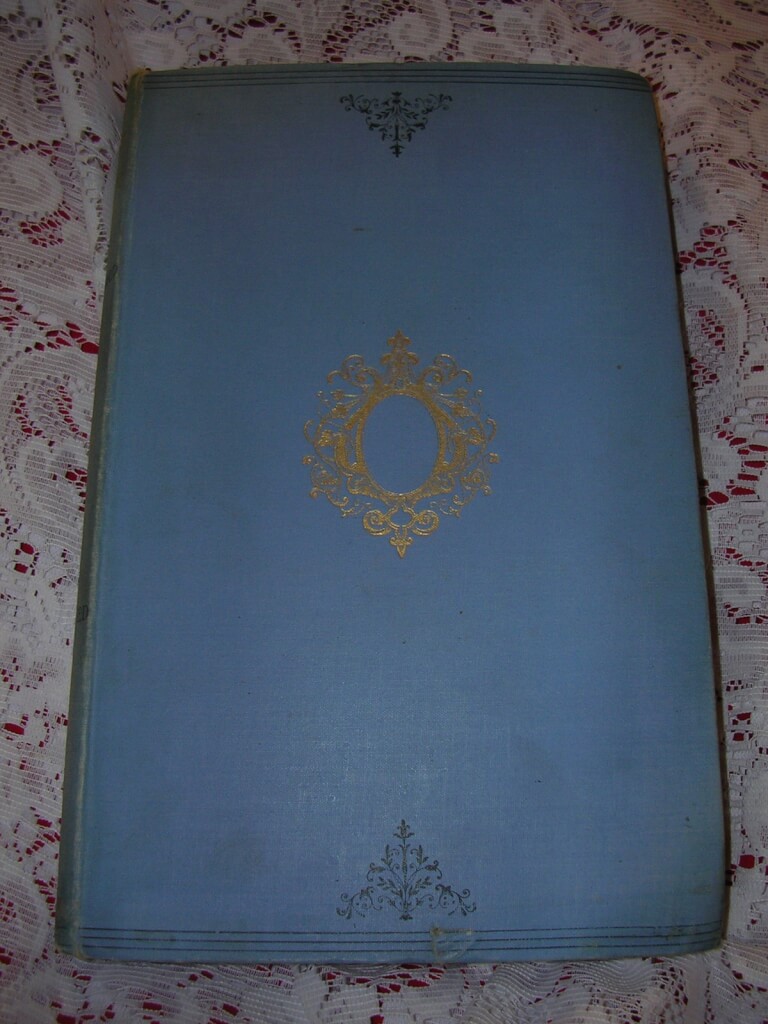 My Uncle Barbassou, Mario Uchard, Paul Avril (illust.) (Vizetelly & Co., London, 1888) 10.25" X 6.5", 339pp., hardbound, blue cloth boards with gilt and black titles and decorations on spine and front cover. Deckled edges. Good condition for age, boards and binding sound, illustrations throughout. Originally published in 4 parts in 1876, "Mon Oncle Barbassou" is a story of a man who inherits his uncle's estate which includes a newly purchased harem of 3 young girls. This novel is a prime example of the French "Orientalists" of the late 1800's. Scandalous for the age, but mild by today's standards, this book is the first English translation. The first English translation from the "Mon Oncle Barbassou" published in 1877. 40 beautiful engravings by Paul Avril. Édouard-Henri Avril (1849-1928) used the pseudonym "Paul Avril" for his erotic work. He was a French painter and commercial artist. His career saw collaboration with influential people like Octave Uzanne, Henry Spencer Ashbee and Friedrich Karl Forberg. He is one of the most celebrated erotic artists of his age. Avril was a soldier before starting his career in art. He was awarded with the Legion of Honour for his actions in the Franco-Prussian War.
My Uncle Barbassou, Mario Uchard, Paul Avril (illust.) (Vizetelly & Co., London, 1888) 10.25" X 6.5", 339pp., hardbound, blue cloth boards with gilt and black titles and decorations on spine and front cover. Deckled edges. Good condition for age, boards and binding sound, illustrations throughout. Originally published in 4 parts in 1876, "Mon Oncle Barbassou" is a story of a man who inherits his uncle's estate which includes a newly purchased harem of 3 young girls. This novel is a prime example of the French "Orientalists" of the late 1800's. Scandalous for the age, but mild by today's standards, this book is the first English translation. The first English translation from the "Mon Oncle Barbassou" published in 1877. 40 beautiful engravings by Paul Avril. Édouard-Henri Avril (1849-1928) used the pseudonym "Paul Avril" for his erotic work. He was a French painter and commercial artist. His career saw collaboration with influential people like Octave Uzanne, Henry Spencer Ashbee and Friedrich Karl Forberg. He is one of the most celebrated erotic artists of his age. Avril was a soldier before starting his career in art. He was awarded with the Legion of Honour for his actions in the Franco-Prussian War. -

 My Secret Life, anonymous (Grove Press, Inc., New York, 1966 [first edition thus, first printing]) 9 1/4" X 6 1/4", 2 vol. 1291pp 1069pp [2nd vol. numbered 1291-2359], hardbound with dust jackets (with protector) and slip case, very good condition, very slight sunning on slip case, Ex Libris Robert Kintzler My Secret Life, by "Walter", is the memoir of a Victorian gentleman's sexual development and experiences. Between approximately 1883 and 1895, someone, presumably an Englishman of means, had printed on the Continent an eleven-volume sexual autobiography limited, so he thought, to just six copies. Who the printer or publisher was has not been established with certainty but the most likely possibility is Auguste Brancart, a prolific publisher of erotica who began his career in the early 1880's in Bruxelles and toward the end of the decade moved to Amsterdam. Interestingly, the original title page of My Secret Life has 'Amsterdam. Not for Publication' on it but in the sub rosa world of erotica publishing such indications are to be taken with a pinch of salt. The scarcity of the first edition of My Secret Life has been overstated; it certainly is a rare book. More than six copies, as ordered, were undoubtedly run off. From the number that have reliably been reported to exist, the number appears to have been in the region of twenty to twenty-five sets. Aleister Crowley was supposed to have had one, as well as the silent film comedian Harold Lloyd and Joseph von Sternberg, Marlene Dietrich's director and one-time lover. Charles Reginald Dawes, the last great English collector of erotica, had two sets, one of which was destroyed the the British Customs and the other going eventually to the British Library in 1964. Lord Louis Mountbatten's brother, the 2nd marquess of Milford Haven, certainly possessed a copy for it exists currently in a fine London collection and contains his bookplate. There is a copy in Geneva, another in Hamburg and at least two in New York. Two attempts to publish a reprint in the United States in the 1930's failed due to police action. The first, which began about 1932, followed the original edition as to title and imprint and got as far as volume three before the project was shut down. A copy with 100 original water colors by Clara Tice was auctioned by Parke-Bernet at New York in 1971. A second attempt took place about two years later, with a single volume called Marital Frolics (London [New York or Philadelphia]: For Distribution by Subscription Only [c. 1934]). This constituted an abridgment of volume 5, and was illustrated with ten plates by 'Malay.' A copy was likewise auctioned by Parke-Bernet in the same sale. The Grove Press reprint of 1966 is the first complete edition to be openly available. It was prepared from an eleven-volume typescript made directly from the copy in Hamburg referred to above. All subsequent reprints stem, legally or otherwise, from this. Gershon Legman's Introduction to the Grove Press reprint is a mine of fascinating information, and includes a closely argued case for My Secret Life having been written by Henry Spencer Ashbee, the famous Victorian bibliographer and collector of erotica. The present compiler is unable to share this view, but thinks it likely that Ashbee was involved in seeing it through the press on behalf of somebody else. This book is often wrongly attributed to Frank Harris, through confusion with My Life and Loves, which is a similar (although not as explicit) account of Harris' life. A number of reprints followed the Grove Press edition, including one published by Brandon House of North Hollywood and Pendulum Books of Atlanta, Georgia and a complete French translation.
My Secret Life, anonymous (Grove Press, Inc., New York, 1966 [first edition thus, first printing]) 9 1/4" X 6 1/4", 2 vol. 1291pp 1069pp [2nd vol. numbered 1291-2359], hardbound with dust jackets (with protector) and slip case, very good condition, very slight sunning on slip case, Ex Libris Robert Kintzler My Secret Life, by "Walter", is the memoir of a Victorian gentleman's sexual development and experiences. Between approximately 1883 and 1895, someone, presumably an Englishman of means, had printed on the Continent an eleven-volume sexual autobiography limited, so he thought, to just six copies. Who the printer or publisher was has not been established with certainty but the most likely possibility is Auguste Brancart, a prolific publisher of erotica who began his career in the early 1880's in Bruxelles and toward the end of the decade moved to Amsterdam. Interestingly, the original title page of My Secret Life has 'Amsterdam. Not for Publication' on it but in the sub rosa world of erotica publishing such indications are to be taken with a pinch of salt. The scarcity of the first edition of My Secret Life has been overstated; it certainly is a rare book. More than six copies, as ordered, were undoubtedly run off. From the number that have reliably been reported to exist, the number appears to have been in the region of twenty to twenty-five sets. Aleister Crowley was supposed to have had one, as well as the silent film comedian Harold Lloyd and Joseph von Sternberg, Marlene Dietrich's director and one-time lover. Charles Reginald Dawes, the last great English collector of erotica, had two sets, one of which was destroyed the the British Customs and the other going eventually to the British Library in 1964. Lord Louis Mountbatten's brother, the 2nd marquess of Milford Haven, certainly possessed a copy for it exists currently in a fine London collection and contains his bookplate. There is a copy in Geneva, another in Hamburg and at least two in New York. Two attempts to publish a reprint in the United States in the 1930's failed due to police action. The first, which began about 1932, followed the original edition as to title and imprint and got as far as volume three before the project was shut down. A copy with 100 original water colors by Clara Tice was auctioned by Parke-Bernet at New York in 1971. A second attempt took place about two years later, with a single volume called Marital Frolics (London [New York or Philadelphia]: For Distribution by Subscription Only [c. 1934]). This constituted an abridgment of volume 5, and was illustrated with ten plates by 'Malay.' A copy was likewise auctioned by Parke-Bernet in the same sale. The Grove Press reprint of 1966 is the first complete edition to be openly available. It was prepared from an eleven-volume typescript made directly from the copy in Hamburg referred to above. All subsequent reprints stem, legally or otherwise, from this. Gershon Legman's Introduction to the Grove Press reprint is a mine of fascinating information, and includes a closely argued case for My Secret Life having been written by Henry Spencer Ashbee, the famous Victorian bibliographer and collector of erotica. The present compiler is unable to share this view, but thinks it likely that Ashbee was involved in seeing it through the press on behalf of somebody else. This book is often wrongly attributed to Frank Harris, through confusion with My Life and Loves, which is a similar (although not as explicit) account of Harris' life. A number of reprints followed the Grove Press edition, including one published by Brandon House of North Hollywood and Pendulum Books of Atlanta, Georgia and a complete French translation. -
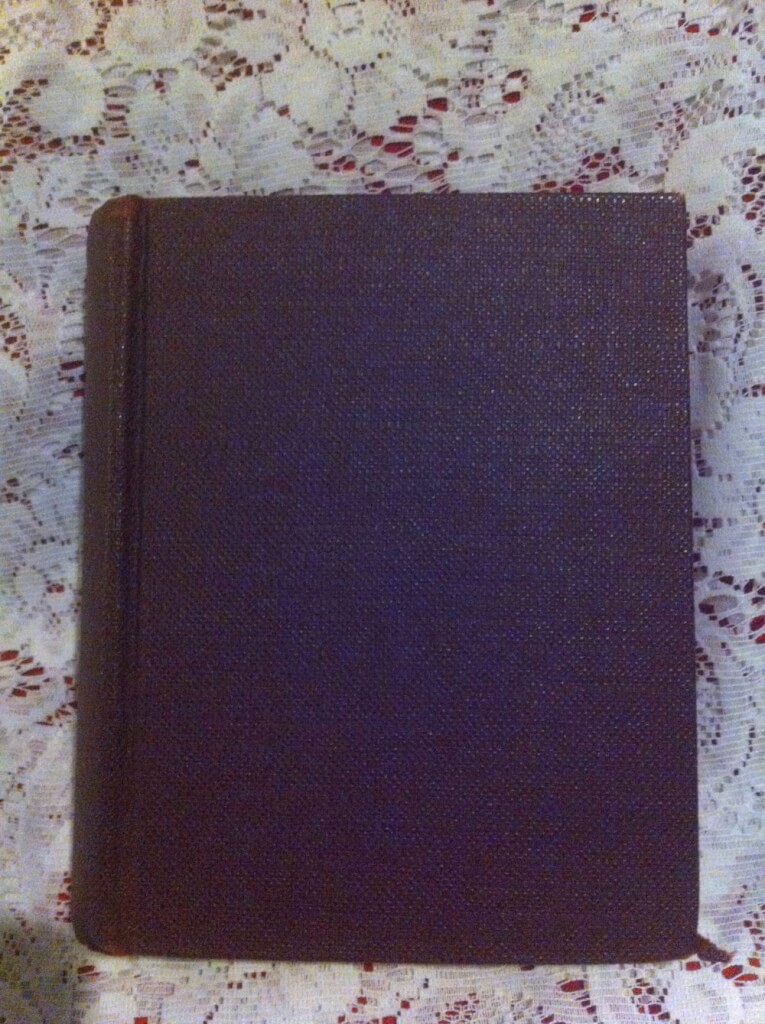
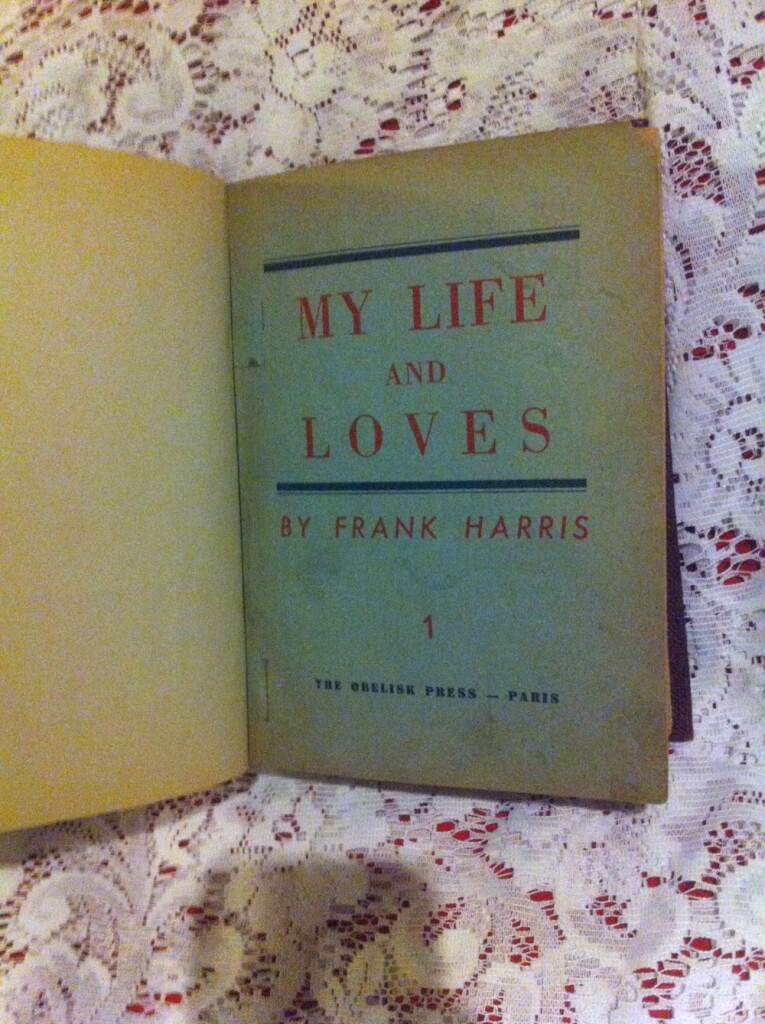 My Life and Loves, Frank Harris (Obelisk Press Books, Paris, 1945) 7" X 5.5", 233pp, 302pp, 176pp, 178pp., 4 vols hardbound in one book, red cloth boards, very good condition for age, pages yellowing no titles on spine or boards. Autobiography of the Ireland-born, naturalized-American writer and editor Frank Harris (1856_1931). Published privately by Harris between 1922 and 1927, and by Jack Kahane's Obelisk Press in 1931, the work consisted of four volumes (with a 5th promised but never delivered). The book gives a graphic account of Harris' sexual adventures and relates gossip about the sexual activities of celebrities of his day. Printed on somewhat cheap paper, these volumes are often in rough shape. This book presents the volumes preserved as best as can be expected for their age.
My Life and Loves, Frank Harris (Obelisk Press Books, Paris, 1945) 7" X 5.5", 233pp, 302pp, 176pp, 178pp., 4 vols hardbound in one book, red cloth boards, very good condition for age, pages yellowing no titles on spine or boards. Autobiography of the Ireland-born, naturalized-American writer and editor Frank Harris (1856_1931). Published privately by Harris between 1922 and 1927, and by Jack Kahane's Obelisk Press in 1931, the work consisted of four volumes (with a 5th promised but never delivered). The book gives a graphic account of Harris' sexual adventures and relates gossip about the sexual activities of celebrities of his day. Printed on somewhat cheap paper, these volumes are often in rough shape. This book presents the volumes preserved as best as can be expected for their age. -

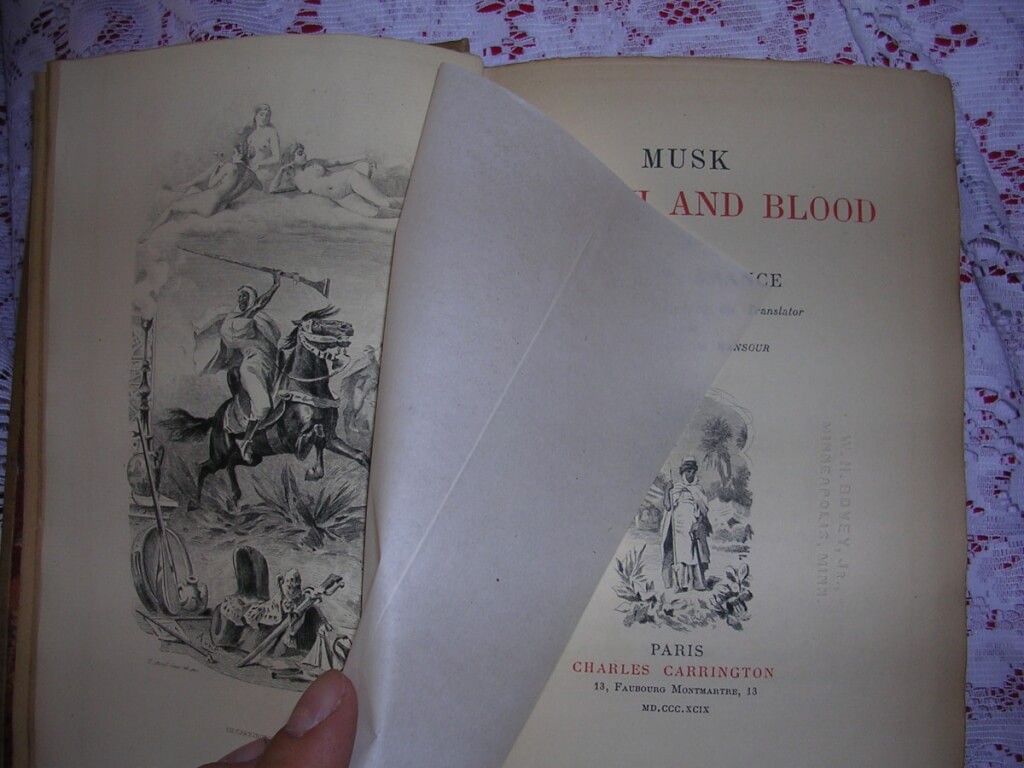 Musk, Hashish and Blood, Hector France, illust. Paul Avril, [trans. most likely Alfred Richard Allinson] (Charles Carrington, Paris, 1899) 8.5" X 5.5", xiii 447pp., hardbound, cloth boards with gilt tittles and decorations. Marbled end papers, deckled edges, frontispiece with tissue guard and numerous illustrations throughout. Good condition, binding is cocked but intact. Owner's signature in front, ink stamp in back, and imprint on title page reads "W.H. Bovey, Minneapolis, MN." Hector France (1837 - 1908) was a French author best known for his "orientalist" and flagellation tales. This graphic and exciting picture of the Algerian desert, its tribes and their astounding customs is a sensational recounting of France's experiences in North Africa. France tells the stories of his adventures in the nineteenth century Arab world from an eyewitness view. "The adventures of a modern man among the cruel men and passionate women of Algiers." Édouard-Henri Avril (1849-1928) used the pseudonym "Paul Avril" for his erotic work. He was a French painter and commercial artist. His career saw collaboration with influential people like Octave Uzanne, Henry Spencer Ashbee and Friedrich Karl Forberg. He is one of the most celebrated erotic artists of his age. Avril was a soldier before starting his career in art. He was awarded with the Legion of Honour for his actions in the Franco-Prussian War.
Musk, Hashish and Blood, Hector France, illust. Paul Avril, [trans. most likely Alfred Richard Allinson] (Charles Carrington, Paris, 1899) 8.5" X 5.5", xiii 447pp., hardbound, cloth boards with gilt tittles and decorations. Marbled end papers, deckled edges, frontispiece with tissue guard and numerous illustrations throughout. Good condition, binding is cocked but intact. Owner's signature in front, ink stamp in back, and imprint on title page reads "W.H. Bovey, Minneapolis, MN." Hector France (1837 - 1908) was a French author best known for his "orientalist" and flagellation tales. This graphic and exciting picture of the Algerian desert, its tribes and their astounding customs is a sensational recounting of France's experiences in North Africa. France tells the stories of his adventures in the nineteenth century Arab world from an eyewitness view. "The adventures of a modern man among the cruel men and passionate women of Algiers." Édouard-Henri Avril (1849-1928) used the pseudonym "Paul Avril" for his erotic work. He was a French painter and commercial artist. His career saw collaboration with influential people like Octave Uzanne, Henry Spencer Ashbee and Friedrich Karl Forberg. He is one of the most celebrated erotic artists of his age. Avril was a soldier before starting his career in art. He was awarded with the Legion of Honour for his actions in the Franco-Prussian War.












